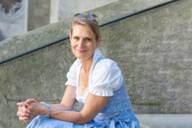
Every year, around six million people visit the Munich Oktoberfest and all want to wear the right attire. But how is a dirndl – the traditional bavarian dress – actually crafted and what should you look out for in a new design? To find out, we spent a workday with Carolin Engelhardt, the founder and creative mind behind ‘Münchner Dirndl’.
“I always say that I am a one-woman show.” Carolin remarks as she opens the door to her shop ‘Münchner Dirndl’ in the heart of the Schwabing neighbourhood at eleven in the morning. “Apart from the bookkeeping, I handle everything myself here in my showroom.” Like many creatives, her working hours vary day by day. “I've had customers knocking at seven in the morning and others arriving at nine in the evening,” she says, as she switches on the lights. What sets Engelhardt's work apart is that her dirndls are not available online. Instead, customers book an appointment in her showroom through her website. “There are so many factors that influence how a dirndl fits,” she explains. “Whether it's hooked correctly, or worn with the right blouse or bra. These one-on-one sessions help to avoid such issues.”
It is the first week of the Oktoberfest, which means Carolin Engelhardt is focused on selling her current models to festival-goers, rather than cre-ating new ones. Still, inspiration for fresh dirndl colours lurks everywhere – in nature, for example: “When I go hiking and see flower colours, I immediately feel inspired to introduce a new shade. But I'm especially drawn to classic, traditional colours that can always be further refined: blues, pinks and greens. I find endless possibilities within these shades.”
Sometimes, she takes inspiration from blossoms and retreats to her studio. Here, colour and fabric samples are pinned to a board, colour charts lie fanned out and a sewing machine with trimmings stands ready by the window. She shows us a colour chart with various greens. “At the moment, I'm in talks with Lodenfrey about whether we should take a bold step by introducing a May green or a bright green,” she says. Lodenfrey, a long-established Munich fashion brand and the specialist shop for traditional attire, has become one of Carolin's biggest customers. Her designs, especially the children's dirndls and her unique ‘Münchner Dirndl’ prints, are among their top favourites.
Engelhard's colour ideas are brought to life in Tyrol, where a partner dyes fabrics to her specifications. “This taupe, for example, is the first colour I created myself,” she says, pointing to a pastel, earthy tone. “And this forget-me-not shade was the second.” A glance at the clothes racks in the back of the room reveals Engelhardt's true favourite dirndl colour: blue. ‘I'm a blue fan – I already have seven shades of blue and have to resist the urge to create an eighth,” she admits.
After inspiration comes the technical part – which Engelhardt believes is the most crucial stage of the process. “You need a basic cut that you can build your designs on. I developed mine with a tailor from Nurem-berg – an acknowledged expert in traditional costume.” She shows us one of these patterns: metre-long rolls of paper with the exact details for the dirndl written in minute detail. Why is the paper so long? “Because we use so much fabric for the skirt – it shows the quality of our dirndls. The sheer amount of fabric is immense.”
It takes months to perfect the cut, explains Engelhardt. “If it were up to me, this process would never end.” She shows us five high-necked dirn-dls that seem identical to the untrained eye. “These are the prototypes of our shawl collar dirndl.” Each model is a step on the way to the final cut. Pointing to the second dirndl on the rack, she says; “Here, I wanted the collar to work as both a stand-up and a fold-over option. But in the next version, the collar was too high, for example. So, the dirndl goes through all these stages.”
The moment you see the dirndl on the customer is often decisive, she says. “That is when I notice the tiniest details. Should I move the button a centimetre up or down? You can only spot these things when the dirndl is on a real person with a real body.” Still, her design is so well-tailored that 50% of her customers can wear their dirndl straight from the shop without any adjustments. “That is already a big success. The others need an alteration. But with my dirndls, that's really easy: My side seam is specially designed for perfect adjustments.”
That afternoon, she has such an appointment: The doorbell rings and a young lady from Chicago steps in, arriving straight from the airport to buy an Engelhardt dirndl for the Oktoberfest. Engelhard carefully pins the dirndl, recommends a balconette bra and switches blouses until both women smile at each other in the mirror. The customer, who discovered Engelhardt on Instagram, says she just “had to have one of her pieces.” When she leaves, it's time for Engelhardt to go to the tailor. She handles minor adjustments herself, but outsources larger ones. With her dirndls in her bike’s basket, she says goodbye – Oktoberfest isn't over yet and this American customer won’t be the last to urgently need a ‘Münchner Dirndl.’